by Ian Skellern
Welcome to the 2016 edition of Quill & Pad’s early Grand Prix d’Horlogerie de Genève predictions in which the team picks favorites and explains why. Please enjoy the opinions of the following panelists:
Ian Skellern (IS), co-founder and technical director
Joshua Munchow (JM), resident nerd writer
GaryG (GG), resident collector
Martin Green (MG), resident gentleman
Ryan Schmidt (RS), author of The Wristwatch Handbook: A Comprehensive Guide to Mechanical Wristwatches and contributor
As a jury member, editor-in-chief Elizabeth Doerr is excluded from these early predictions.
The Mechanical Exception category is defined by the GPHG as, “watches featuring a special mechanism such as an innovative or sophisticated display, an automaton, a striking or any other acoustic function, a belt-driven movement, or any other original and/or exceptional horological concept.”
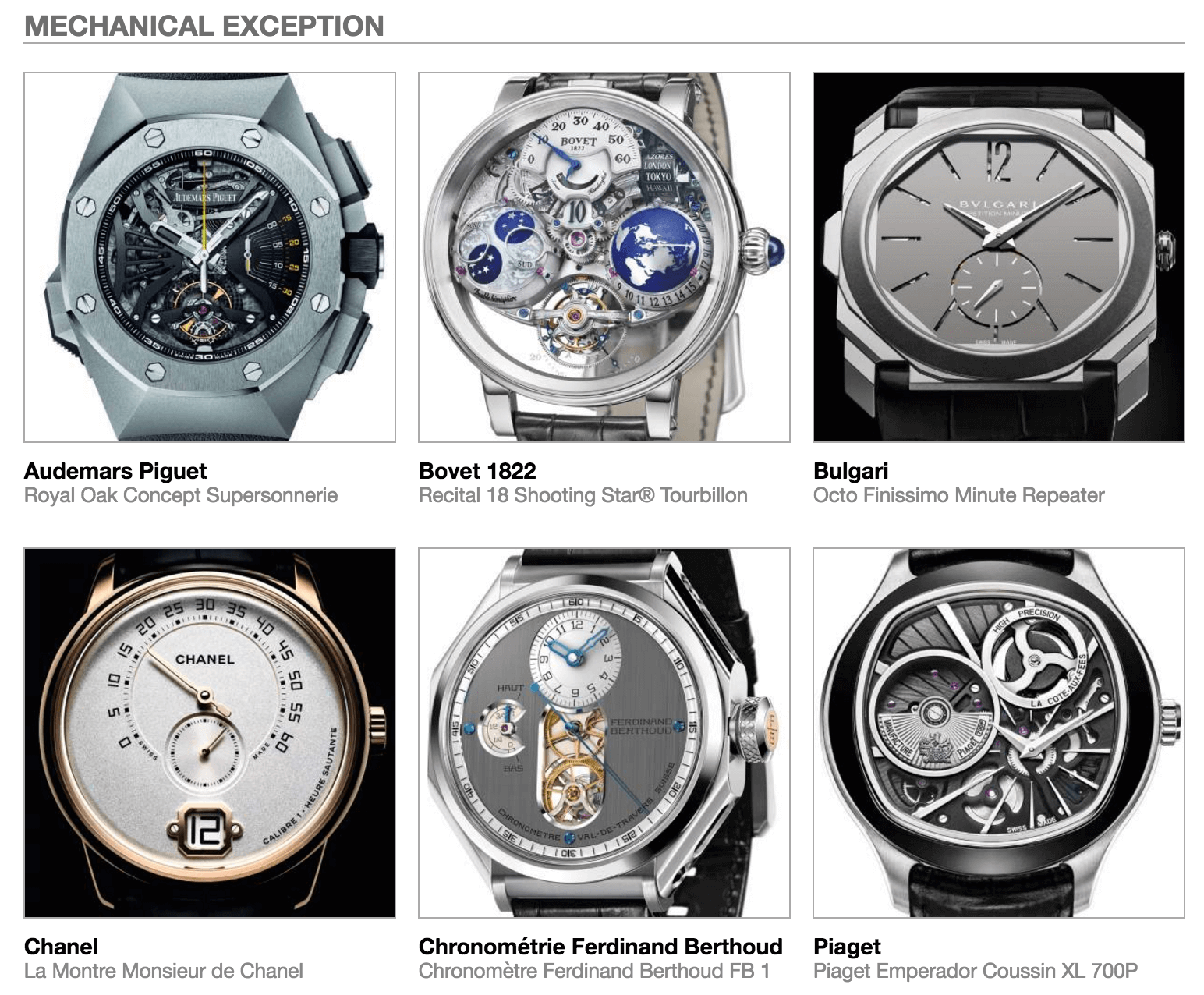
Pre-selected Mechanical Exception watches in the 2016 Grand Prix d’Horlogerie de Genève
IS: This is the most difficult category so far to decide on a winner because it’s like having to choose which is better: the perfect apple or the perfect orange. The winner is likely to be decided by how many of the jury prefer apples and how many prefer oranges. Or how many prefer their minute repeaters to be loud and clear and how many prefer them to be thin. Or, for that matter, how many of the jury are impressed with repeaters at all.
JM: Out of all the categories in this year’s Grand Prix, this is the only category that in my opinion is so lopsided that the real question isn’t which watch will win, but which watch you would pick beside the winner. Every single pre-selected watch in this category is beyond incredible and every one of them would be a possible winner if not for one standout among standouts. This is a tough category regardless because I can find so many things to love and so very many things to lust after.
RS: This is my favorite category. The range of watches this year is amazing; and I am not just talking about the preselected list. The full list of competing watches for the year is technically highly impressive, and visually (our aurally) the offerings combine to form a carnival of mechanics!
Liquid time, digital time, spinning time: some very cool watches failed to make it into pre-selection, perhaps on account of them not being entirely new this year, perhaps because some of them polarize the appreciation of enthusiasts. Consequently, my top picks are all new and all singing and dancing.
Piaget Emperador Coussin XL 700P
IS: I’ve done my best to put aside my bias for purely mechanical wristwatches in the GPHG (and life), but cannot understand how the Piaget Emperador Coussin XL 700P came to be preselected. It is undoubtedly an excellent wristwatch and I like the dial-side micro rotor.
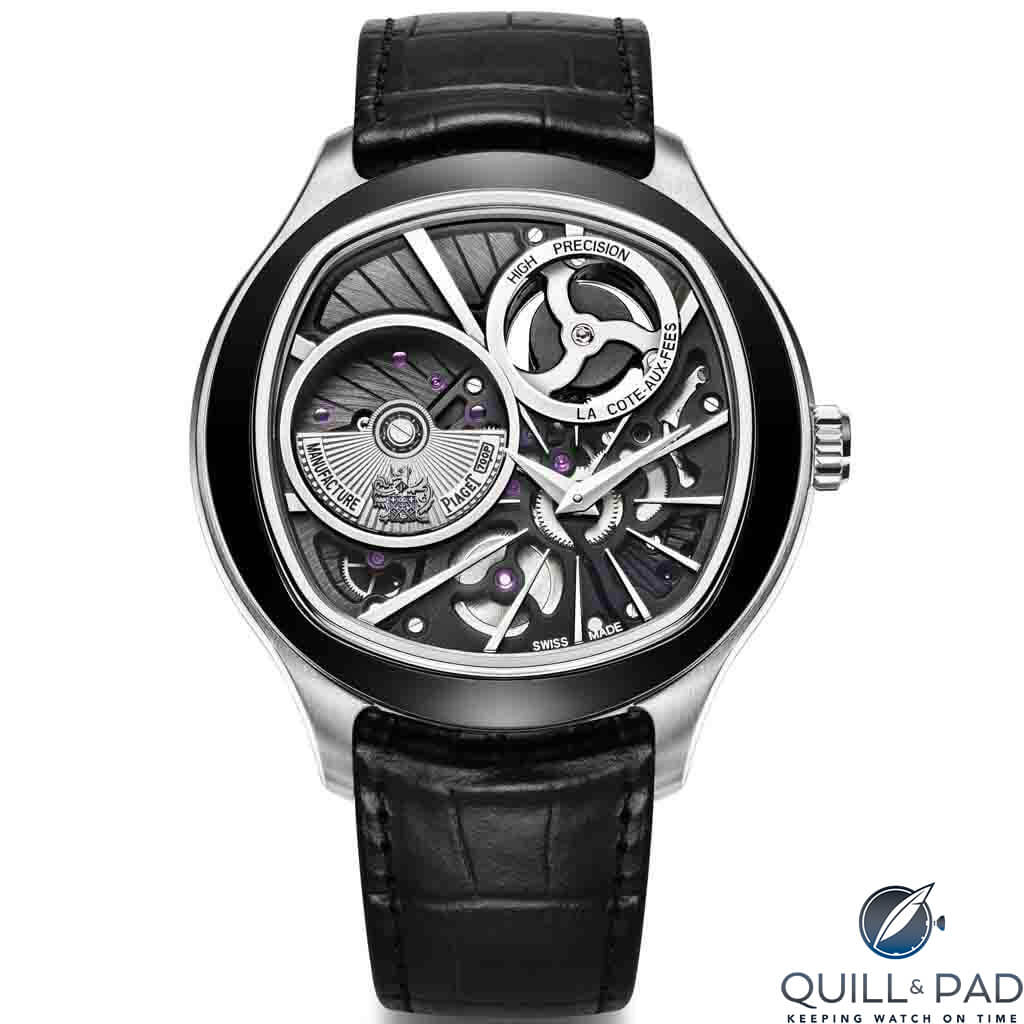
Piaget Emperador Coussin XL 700P
The quartz regulator certainly provides much improved accuracy over a mechanical regulator, but that’s been around for years if not decades: Seiko, Citizen, and even Jaeger La-Coultre have all brought out mecaquartz models over the years.
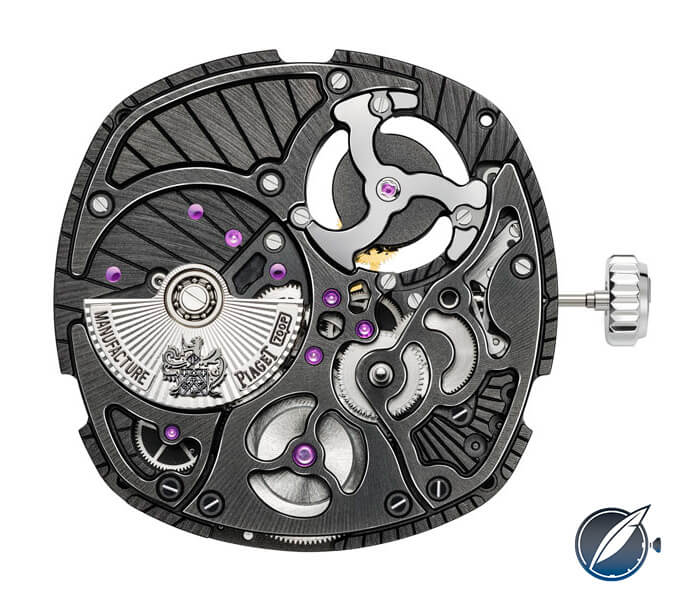
Dial side of the hybrid Caliber 700P inside the Emperador Coussin XL
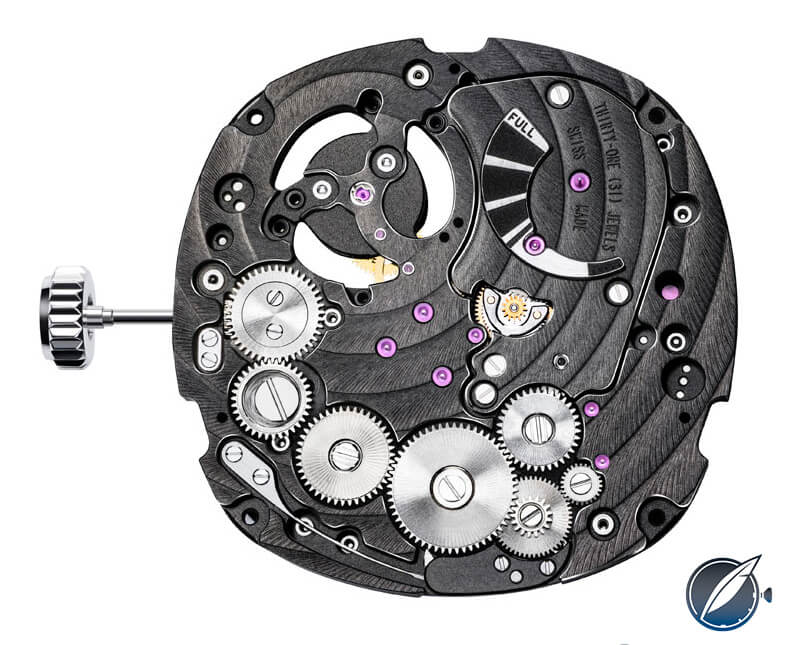
Movement side (back) of the hybrid Caliber 700P inside the Emperador Coussin XL, with the 42-hour power reserve indicator top right
I first assumed that the 700p made the cut because there was nothing better to choose from. But it was selected over the Zenith Tourbillon Georges Favre-Jacot with chain and fusée and the ArtyA Minute Repeater with 3 Gongs, Regulator & Double Axis Tourbillon 1/1.

Piaget Emperador Coussin XL 700P
The Piaget Emperador Coussin XL 700P is a great watch but it’s incomprehensible to me as to how it came to be pre-selected in this category. And I’ll take the lack of comments from my colleagues as a sign that we may agree on that.
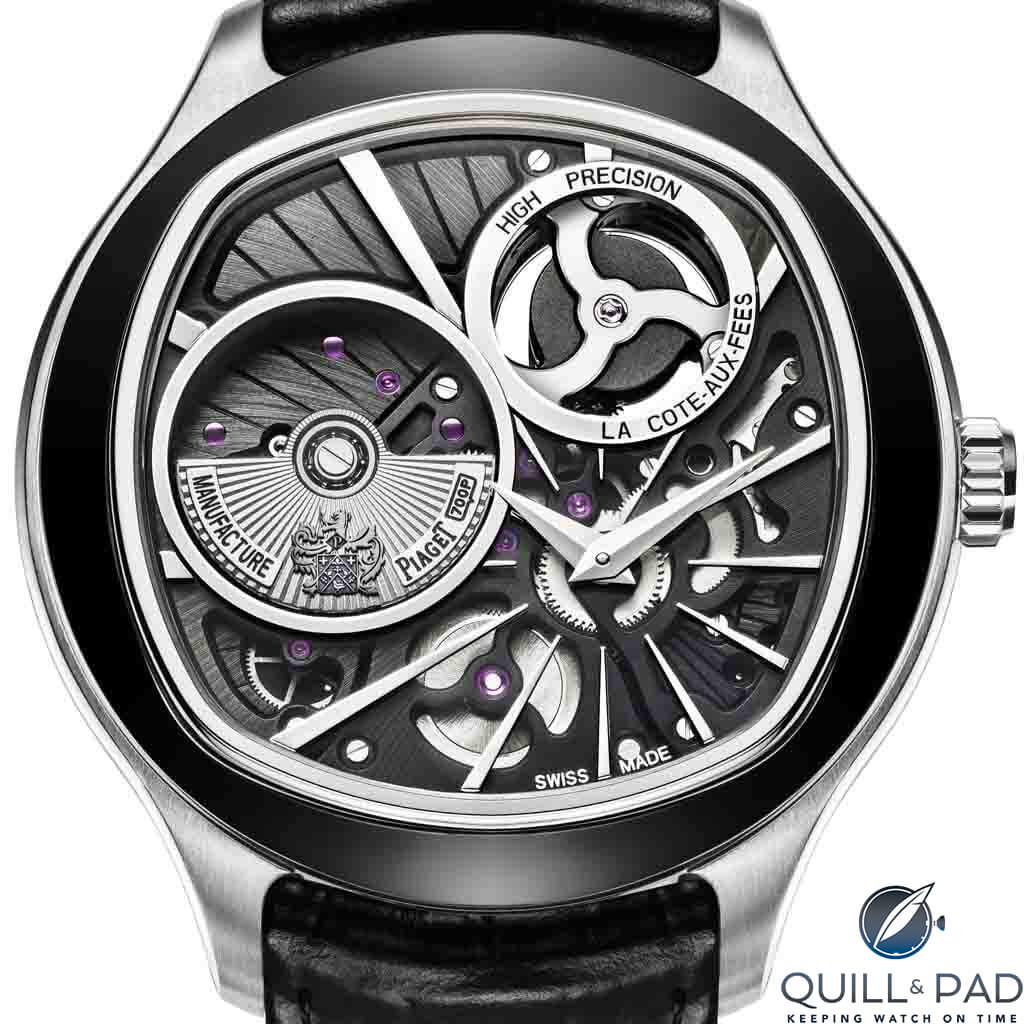
Piaget Emperador Coussin XL 700P
Further reading: Piaget Emperador Coussin NL 700P: Hybrid Performance, Piaget Perfection.
Quick Facts Piaget Emperador Coussin XL 700P
Case: white gold with black ADLC-coated bezel, 46.5 x 10.4 mm
Movement: automatically winding hybrid Caliber 700P with quartz generator and 42-hour power reserve
Functions: hours, minutes; power reserve
Limitation: 118 pieces
Price: $70,800 / 76,000 Swiss francs
Chanel La Montre Monsieur de Chanel
RS: Chanel deserves recognition for what is a genuinely impressive movement and a fresh presentation of the jumping hour and retrograde minutes. The Monsieur de Chanel startled many when it was released; it’s a lovely watch with a lovely movement, but I think it’s the brand name that caused so many people to do a double, and even triple, take.

Chanel La Montre Monsieur de Chanel
When you look at the movement you immediately get a sense of the significant upgrading that has clearly taken place at Chanel (excluding perhaps the APRP-partnered J12 Rétrograde Mystérieuse). It’s not a widely known fact, although it was reported right here, that Chanel invested in Romain Gauthier, and consequently Gauthier’s workshop is behind some of the components and reflected in the overall look and feel of the Caliber 1 movement.
If this sort of pollination was strategically what Chanel had in mind with the investment, I wholeheartedly approve. The watch is a highly attractive statement of Chanel’s intent; it hits the bull’s eye, just not the mechanical exception bulls eye.
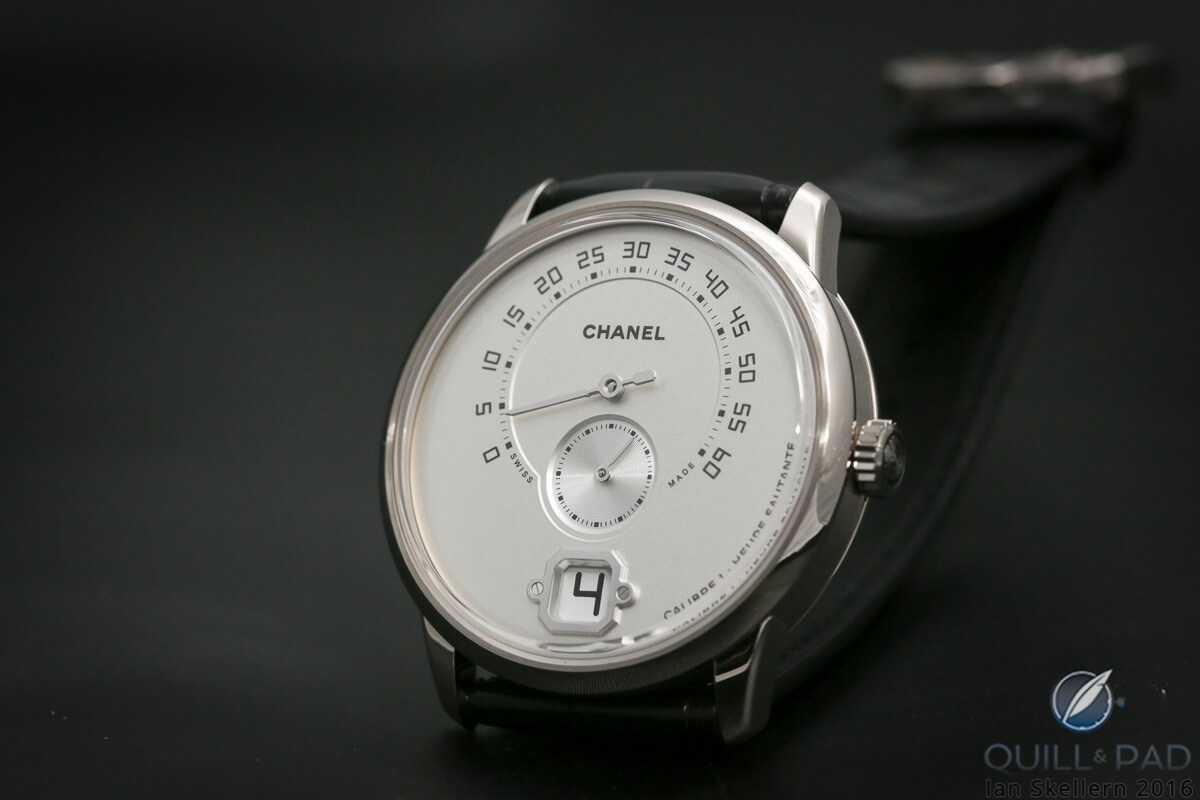
Monsieur de Chanel in white gold
IS: The Chanel La Montre Monsieur de Chanel is yet another great watch that doesn’t really fit a category well enough to excel. It would be a very strong contender as a Men’s watch for me, but both retrograde and jumping indications are excluded from that category. Visually clean and minimalist with excellent technical credentials, the Monsieur de Chanel is a superb first in-house by the brand and evidence that the collaboration with Romain Gauthier is paying dividends.

Chanel La Montre Monsieur de Chanel
Further reading: Surprising Ties That Bind: Chanel And Romain Gauthier.
Quick Facts Chanel La Montre Monsieur de Chanel
Case: 40 x 10.4. mm, beige gold
Movement: manually wound Caliber 1 with twin serially operating spring barrels for a three-day power reserve; 4 Hz / 28,800 vph
Functions: jump hours, retrograde minutes, seconds
Limitation: 150 pieces
Price: 32,000 Swiss francs
Chronométrie Ferdinand Berthoud FB 1
RS: Be still my beating heart: the FB 1 is absolutely breathtaking. Where some watches use a tourbillon almost entirely for the aesthetic, this regulator feels very much part of the overall technical brief. Combined with the traditional fuseé and chain and a 1,120-part chronometer-grade movement, the FB 1 is every bit as captivating and scientific as the marine chronometers that amazed the world more than 200 years ago.
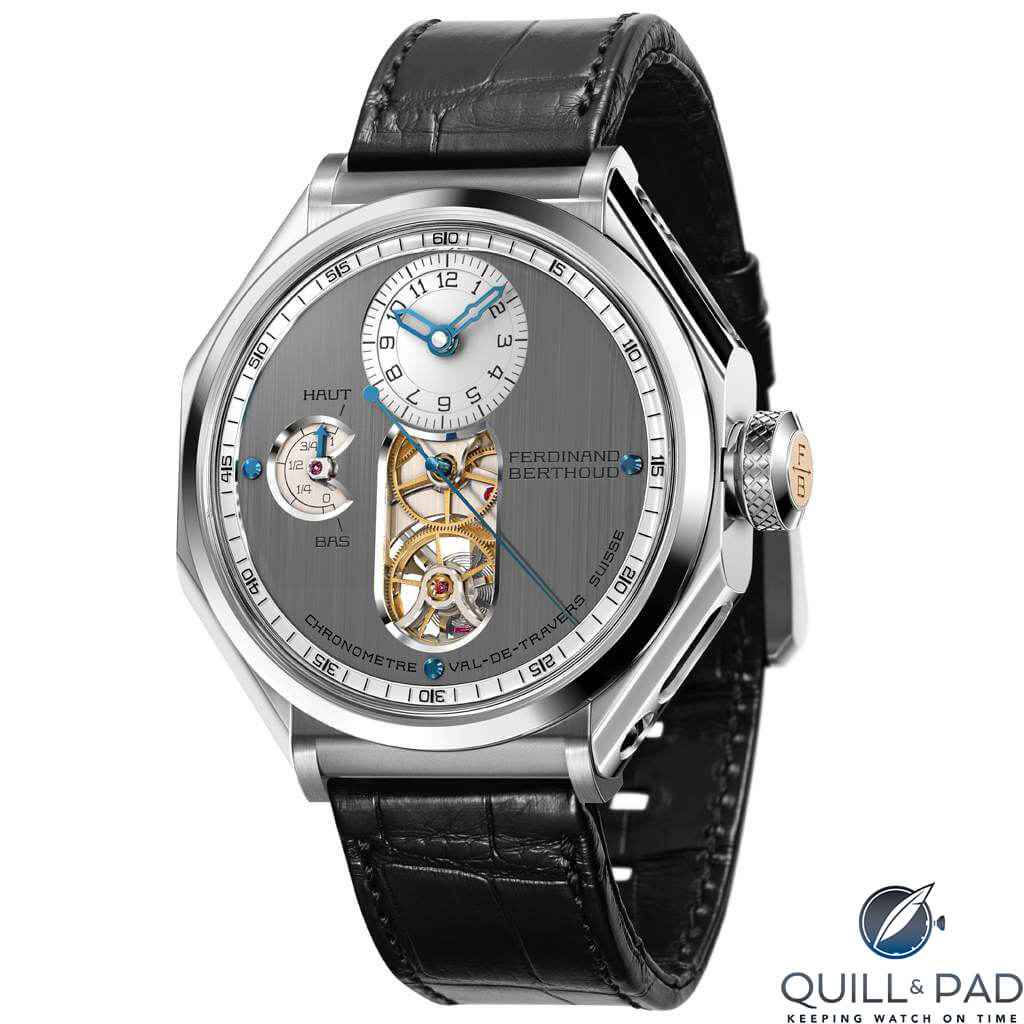
Chronométrie Ferdinand Berthoud FB 1
What makes the FB 1 the winner, in my opinion, is the movement architecture. The pillared design is a step even further into the marine chronometer past; it brings forth the same wonder that only the likes of Thomas Mercer is currently creating at clock-scale. This is a marvelous watch, it’s seriously technical and technically serious; there is nothing that comes close to it in my opinion.
MG: Entering the haute horlogerie scene is challenging enough, but Ferdinand Berthoud reaches immediately for the crown. I like the unconventional looks that sets it apart from the crowd as well as its modesty to make the oversized tourbillon mainly a private pleasure of its owner by putting it on the back of the watch.
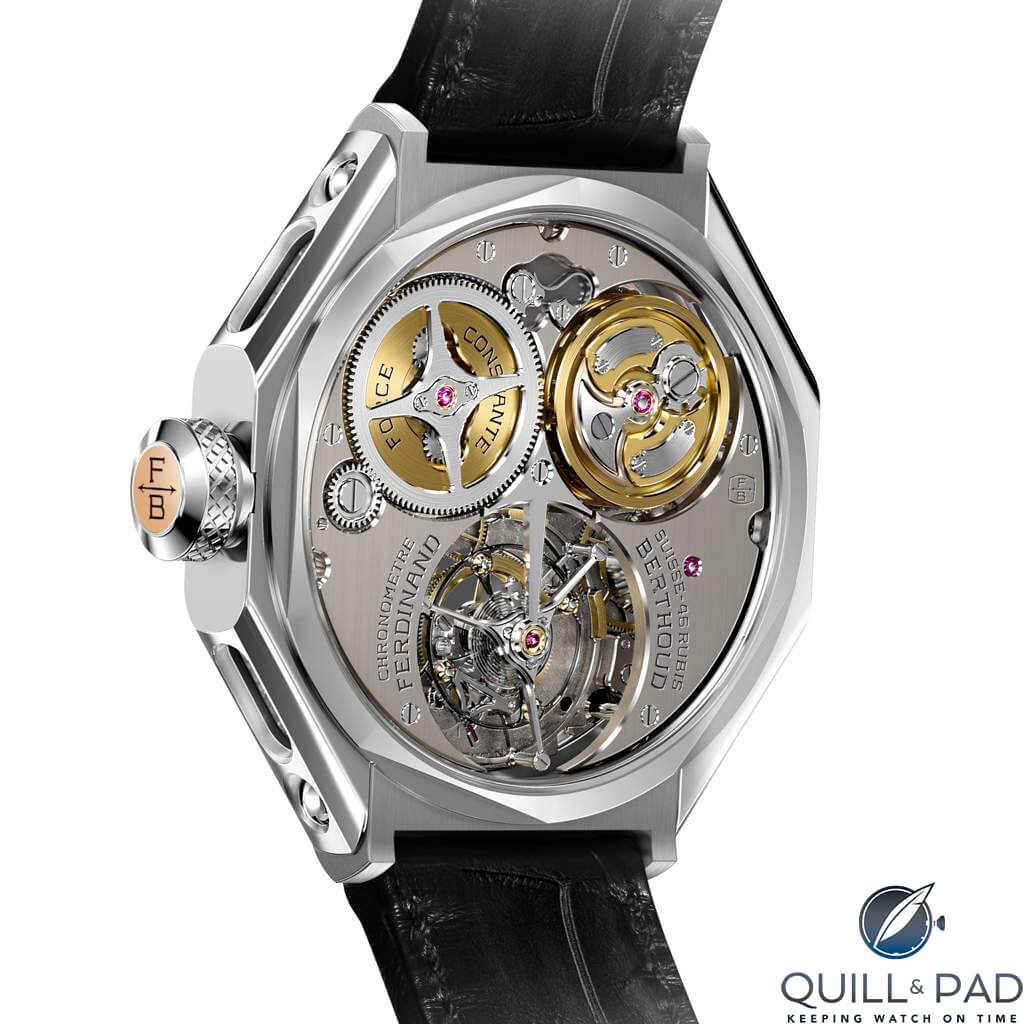
View through teh display back of the Chronométrie Ferdinand Berthoud FB 1
IS: I was so strongly put off by the aesthetics of the Chronométrie Ferdinand Berthoud FB 1 that I could not fully appreciate its technical merits; however, now that I have grown more used to its distinctive octagonal case and instrument-like dial, I find myself liking it more and more both inside and out. As the watch that launched the brand, the FB 1 makes for a very powerful statement of intent.
Both the design and the complications of FB 1 are in line with Ferdinand Berthoud‘s (the man, not the brand) superlative marine chronometers (the eighteenth-century Swiss horologist was appointed horologist-mechanic to the king of France). The clever suspended chain and fusée constant force system is very compact, and I’ve evolved from feeling turned off by the design to being attracted by it. While I have decided on another as my pick for the laureate here, the Chronométrie Ferdinand Berthoud FB 1 is an extremely strong contender.
JM: This watch represents the fantastic ability of a new brand to come out with something surprising and remarkable. The movement design of this piece has to be one of my favorite mechanical designs of the past year, and that is saying something. It probably has to do with the fact that it looks as if it was built 250 years ago, but it’s completely modern.
The aesthetic of the FB 1 Chronometer is pure watchporn, and the restraint shown while building such an awesomazing movement brings this watch from incredible to downright stupendous. It feels as if it has been locked in a time capsule for two centuries after being built centuries ahead of its time. I feel this watch rivals any small-batch horology on the market and would definitely win top honors in almost any category. Except this one, this year.
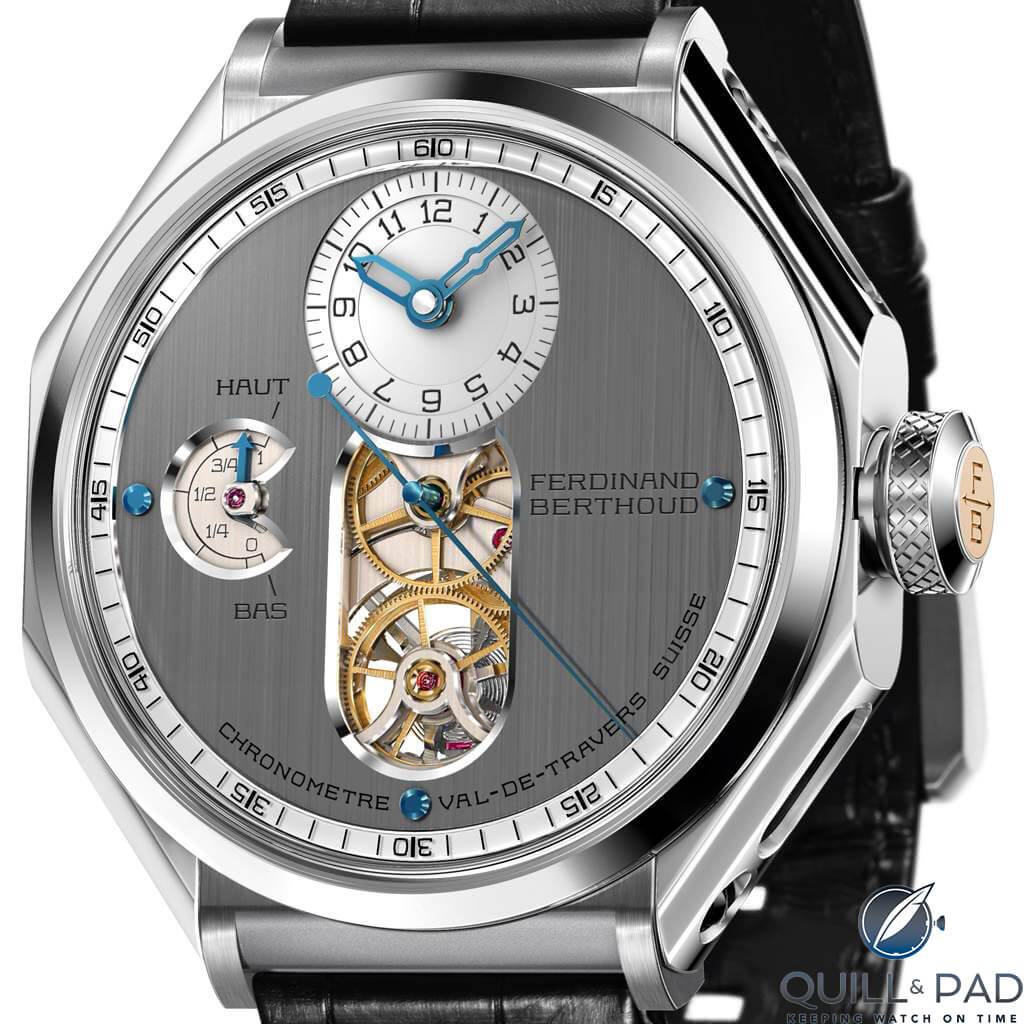
Chronométrie Ferdinand Berthoud FB 1
Further reading: Ferdinand Berthoud Is Reborn With FB 1 Thanks To Chopard’s Karl-Friedrich Scheufele.
Quick Facts Chronométrie Ferdinand Berthoud FB 1
Case: 44 x 13 mm, white gold and titanium, no lugs
Movement: hand-wound Caliber FB-T.FC with chain-and-fusée constant force system, one-minute tourbillon, and pillar-style architecture, 3 Hz frequency and 53 hours power reserve, C.O.S.C. certification
Functions: hours, minutes, central seconds; power reserve display
Limitation: 50 pieces
Price: €220,000 / 212,000 Swiss francs
Bovet 1822 Récital 18 Shooting Star Tourbillon
MG: The Bovet Récital 18 Shooting Star not only offers a unique combination of complications, but also presents them with a sense of drama that surpasses all other watches in this category. The cherry on top is that it does so in a way that still allows it to be very easy to read. That is, of course, when you are not distracted by the incredible details that this watch offers. This watch is not a shooting star, but a horological super nova!
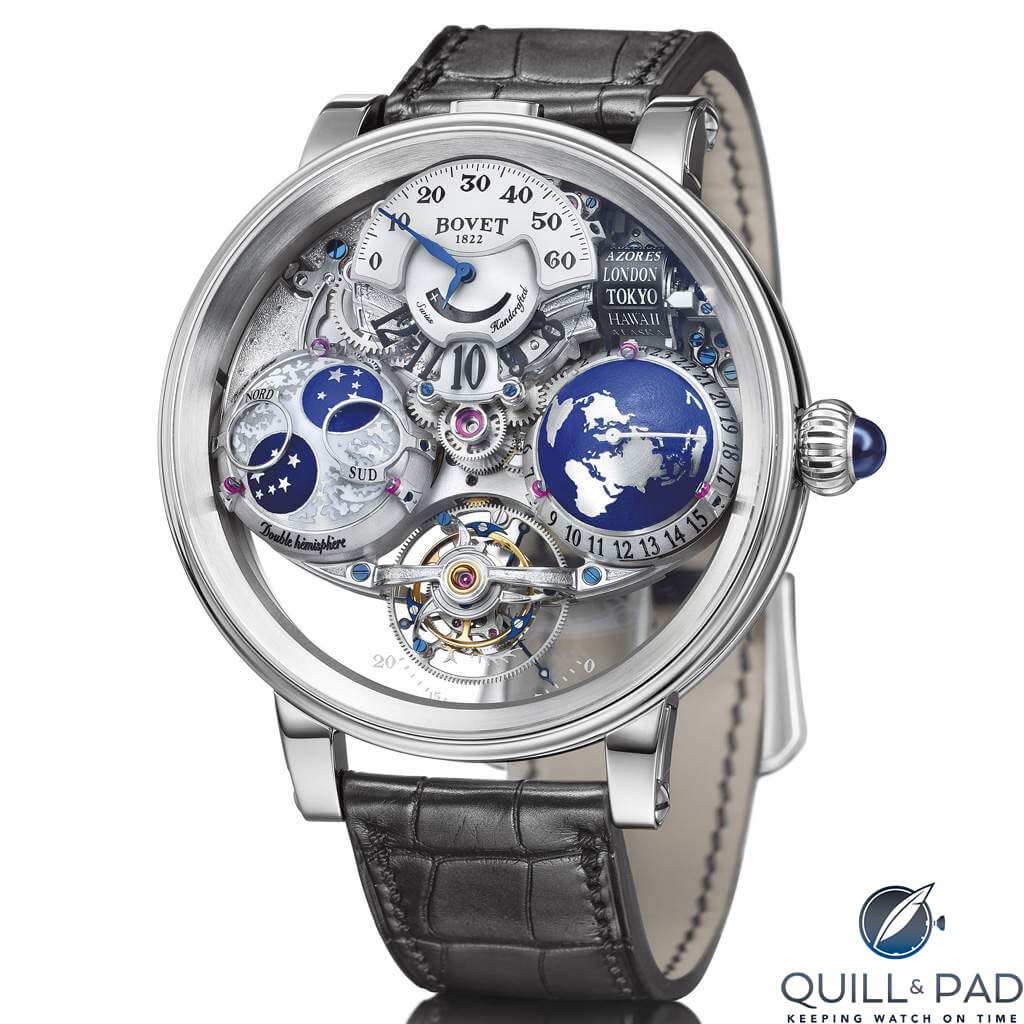
Bovet 1822 Récital 18 Shooting Star Tourbillon
GG: Who knew I would love an ornate Bovet! The florid house style is still really not to my taste, but the stack of features incorporated in this watch pleases as much as it overwhelms. Five-day power reserve, hemispherical globe and compact city name wheel to indicate world time, hemispherical moon with indications for both the Northern and Southern Hemispheres, all topped off with jumping hours and retrograde minutes. Other than that, not much going on!
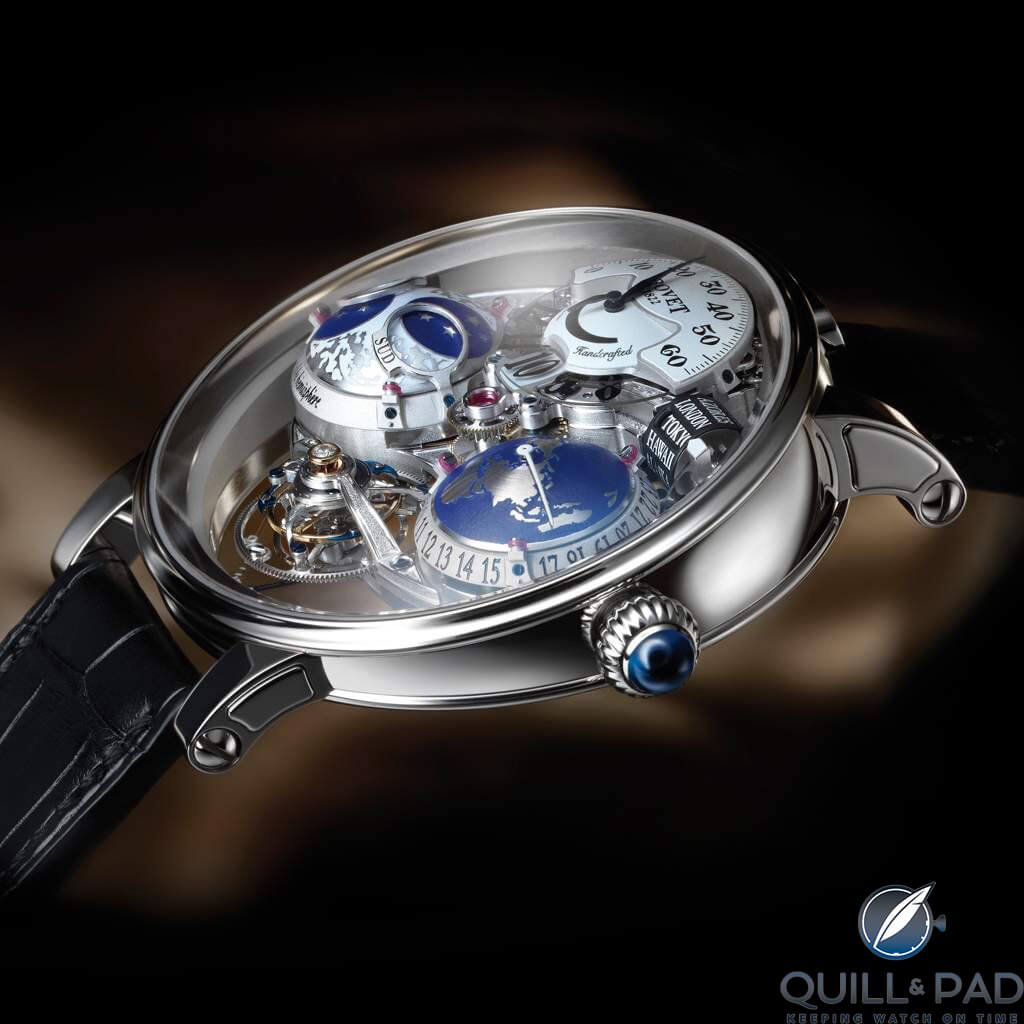
Bovet 1822 Récital 18 Shooting Star Tourbillon (note the angled case)
IS: While I have always respected Bovet for the quality, artistry, and innovation in the brand’s timepieces, as Gary expressed, the designs have usually been too ornate for my taste. That changed for me in a big way with the Ottantasei by Pininfarina (see Transparently Sublime Bovet Ottantasei By Pininfarina: Near Perfection, Bar One Tiny “Flaw”), which I picked as this year’s winner of the Tourbillon Category (see Predictions In The Tourbillon Category Of The 2016 Grand Prix d’Horlogerie de Genève). But the Ottantasei wasn’t at all ornate, in fact it was the antithesis of ornate and didn’t look anything like the majority of Bovet’s lineup.
The Récital 18 Shooting Star Tourbillon on the other hand is 100 percent Bovet’s more typical style, but the whole thing just works for me visually. And technically, what a sensation and plethora of useful, legible, and technically interesting indications: long 120 hour power reserve, moon phase, retrograde minutes, jumping hours and for the frequent traveler, both a second time zone (cities named on dual rollers) and global time. Plus there’s a tourbillon thrown in for good measure. I really do like this watch.
JM: This watch is a feast for the eyes and a wonder for the wrist. It has dual hemispherical domes to display world time on one and moon phases on the other, with two moon phase indicators for the northern and southern hemisphere. The world time hemisphere has a coinciding 24-city roller that indicates which city the meridian pointer is adjusted for. Then you have the retrograde minutes and jump hours that add even more visual interest and complication. A power reserve indicator is placed in the middle of the time indication that helps you keep track of the stout five-day power reserve.

Bovet 1822 Récital 18 Shooting Star Tourbillon
Below everything I’ve already mentioned perches the delicately situated tourbillon, a favorite feature for Bovet, and given the transparent nature of the case and movement, allows the running seconds to be printed onto the sapphire crystal. This watch is truly an incredible assembly of horology, and yet it still comes in third given the ridiculously stiff competition.
Further reading: Above And Beyond: Bovet Récital 18 Shooting Star.
Quick Facts Bovet 1822 Récital 18 Shooting Star Tourbillon
Case: 46 x 18.15 mm, white gold
Functions: jumping hours, retrograde minutes, seconds (on tourbillon); hemispheric universal world time with selectable time zone and ultra-compact 24-city indicator, hemispheric precision moon phase
Movement: manually wound Bovet Caliber 17DM01-HU with one-minute tourbillon, 5 days’ power reserve
Limitation: 50 pieces
Price: 295,000 Swiss francs
Bulgari Octo Finissimo Minute Repeater
RS: The manufacture at Bulgari has been firing from its big guns for some time, and this particular model is one of the most compelling and impressive I have seen. The slimness of the case (it truly is ultra-thin) matched with the robust design and matt-finish titanium makes for an intriguing look. What particularly impresses me is the sandwich dial. Rarely seen outside of Panerai, this particular sandwich does not have a lume filling, instead it is a beautiful mechanical sandwich!
MG: The Bulgari Octo Finissimo Minute Repeater looks like a contemporary sculpture that just happens to hold the record for the thinnest minute repeater movement. Expressive and understated rarely went so well together in a single watch.
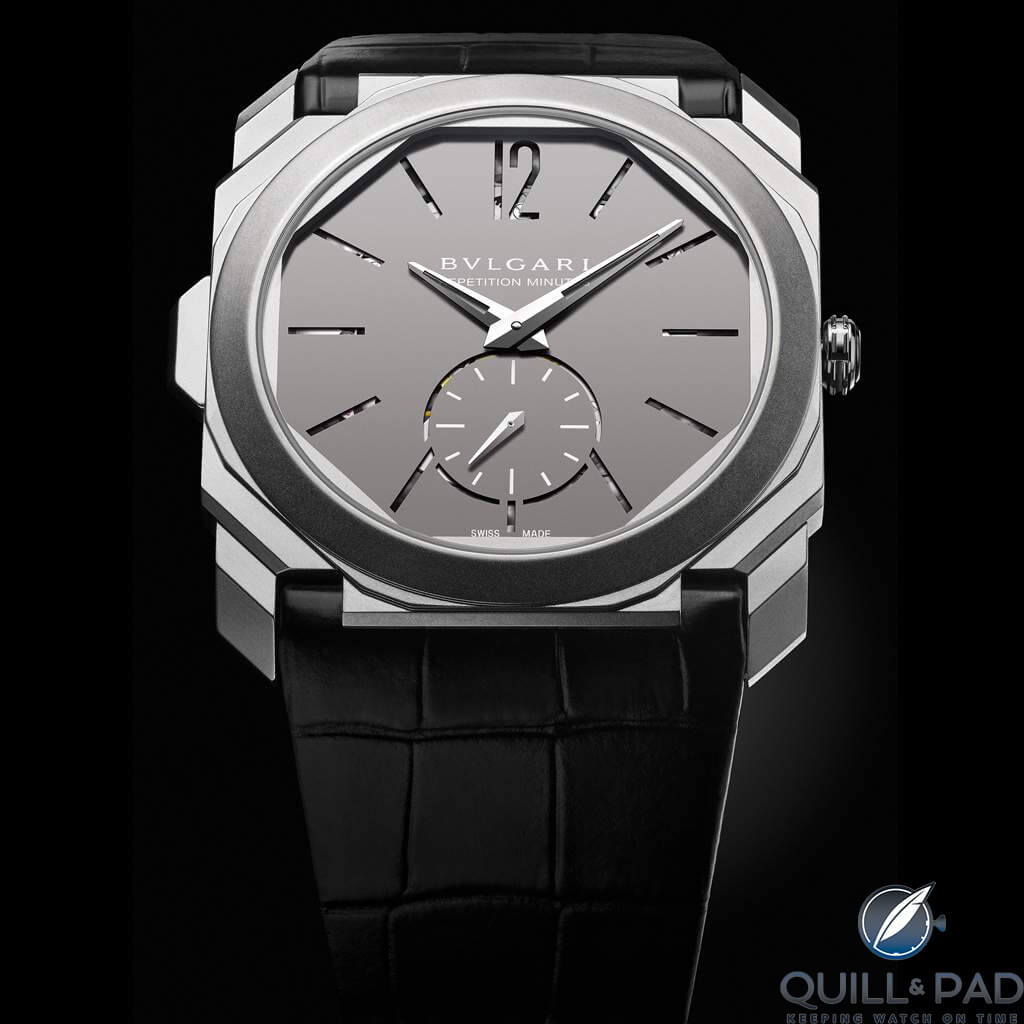
Bulgari Octo Finissimo Minute Repeater
IS: The Finissimo Minute Repeater is truly an exceptional wristwatch, not just because of its extreme world-record slimness but because that svelte size has been used to make both an easy wearing watch that is still a very credible sounding minute repeater. The big decision I faced for my choice of winner was whether to go for size (the Finissimo) or sound (the Supersonnerie). In the end I came down on the side of sound, but it was a tough call.
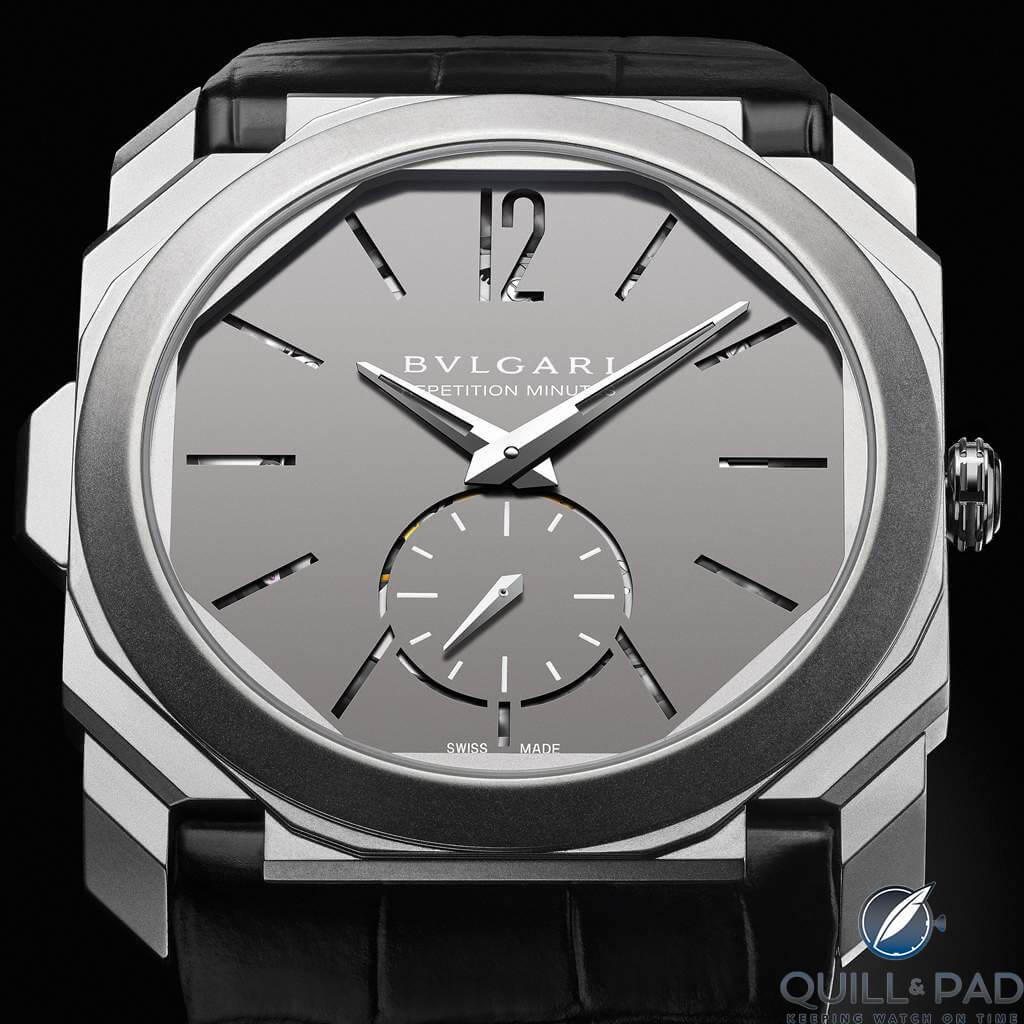
Bulgari Octo Finissimo Minute Repeater, the slots in the dial are to allow more sound waves through
GG: What a great watch! Ultra-thin – Bulgari claims it to be the thinnest minute repeating watch on the market today – beautifully styled, wearable at 40 mm in diameter, and cleverly designed with features for better sound propagation including a titanium case cut-out indices for the hours.
For more information, please visit www.gphg.org/horlogerie/en/watches/octo-finissimo-minute-repeater.
Quick Facts Bulgari Octo Finissimo Minute Repeater
Case: 40 x 6.85 mm, titanium
Movement: manually winding Caliber BVL 362, only 3.12 mm in height
Functions: hours, minutes, seconds; minute repeater
Limitation: 50 pieces
Price: 160,000 Swiss francs
Audemars Piguet Royal Oak Concept Supersonnerie
JM: There can be no other, and alone it must be. This watch has redefined what is possible with a chiming watch in every possible way. The amount of research and engineering that was put into this concept is beyond anything any other watch brand has done in recent memory. After hearing the prototype watch two years in a row, I can attest that this is the single best-sounding minute repeater you might ever hear unless they can make it better. It features so much acoustical technology that it can hardly be considered just a watch; it is a high-precision musical instrument.
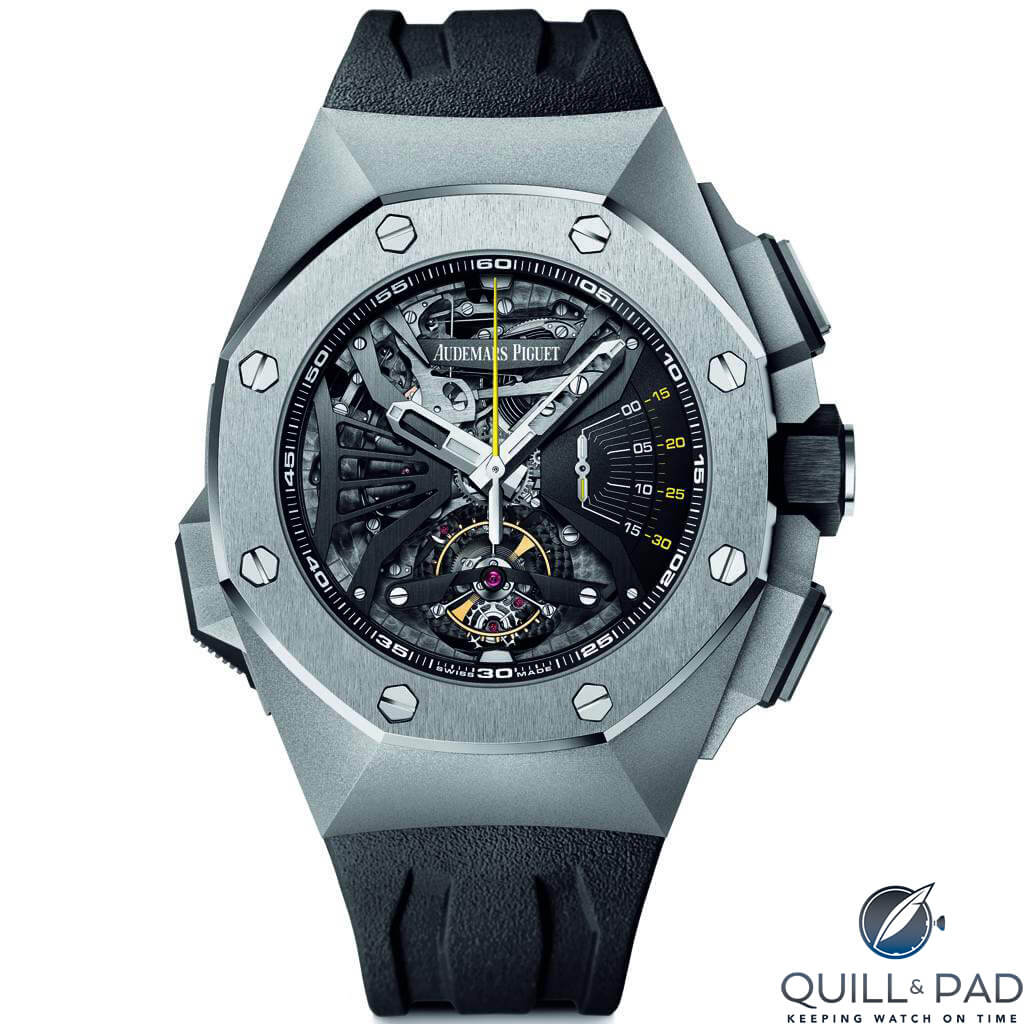
Audemars Piguet Royal Oak Concept Supersonnerie
And it doesn’t end there: the Royal Oak Concept Supersonnerie also features a chronograph and a tourbillon just for good measure. If having the best-sounding chiming watch in history wasn’t enough, they threw in more complications just for good measure. It’s as if Audemars Piguet realized that it had a winning lottery ticket but wanted to be safe so bought another one that also happened to be a winner.
I have always loved the Royal Oak Concept pieces, and this one is no different. The aesthetic is fun and futuristic, and the case design is always bold. But most importantly, this watch performs amazingly well in every aspect. Simply put, it is the most mechanically and technically impressive timepiece in the competition this year. And after seeing the other categories, that is really saying something. I dare say it might just edge out some other favorites for the Aiguille d’Or as well . . .
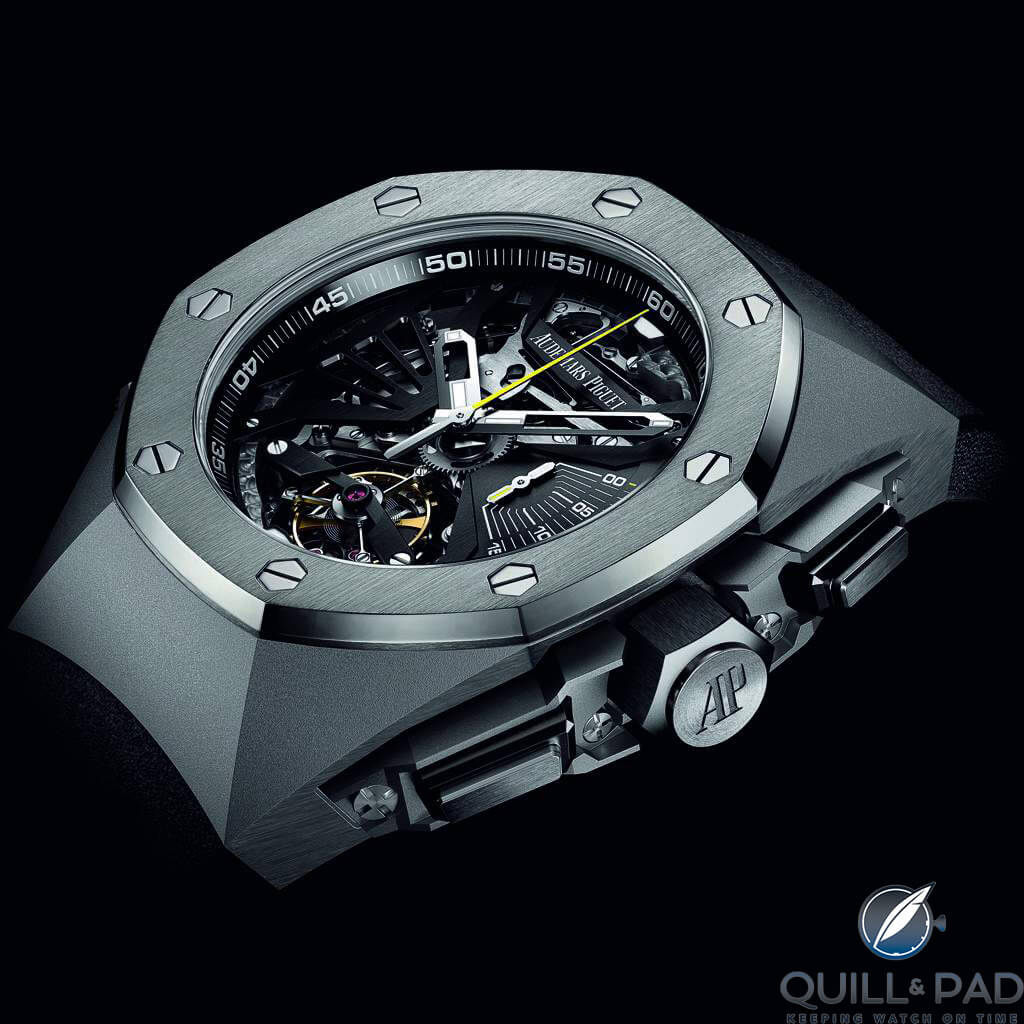
Audemars Piguet Royal Oak Concept Supersonnerie
GG: My vote for “best of the rest” after the Bulgari and Bovet goes to the Audemars Piguet. I heard the watch (taken out into a hallway, out of our sight) at SIHH, and the sound was indeed marvelous. But this year, that’s not enough to win my vote in this category against strong competition.
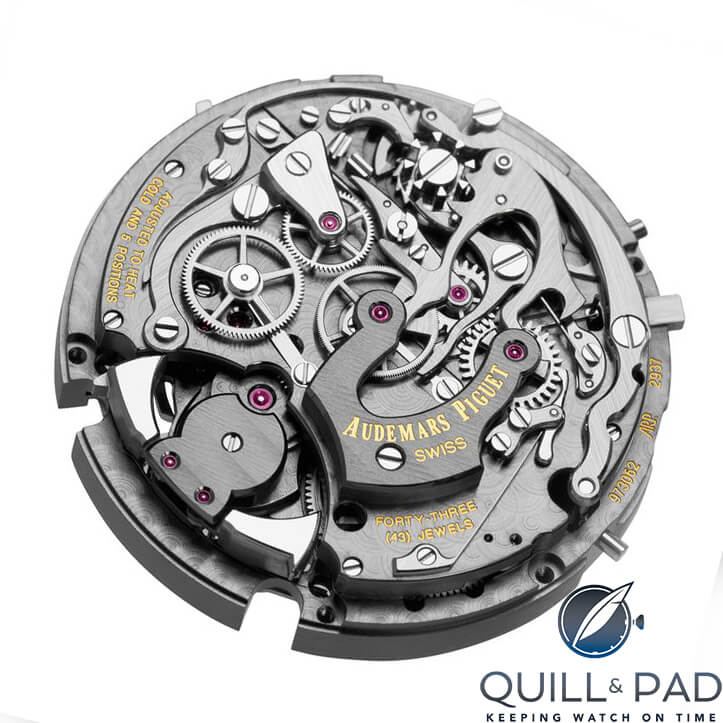
The Audemars Piguet Caliber 2937, the beautiful movement inside the Supersonnerie
IS: At least three other wristwatches here might credibly have taken the Mechanical Exception category this year, but only if Audemars Piguet had chosen another year to enter the Supersonnerie. What makes it my clear winner isn’t that it heralds a revolution in chiming watches, but has painstakingly and meticulously improved the repeater in all aspects of its design and construction, using the latest advances in the science of audio.
You really need to hear the Supersonnerie to appreciate just how good it is as the sound isn’t just loud, and sounds even louder on the wrist, but crystal clear with a pleasing tempo. And no long pregnant pauses when there are less than three quarters (15 minutes) to strike.
That would have been more than enough for me to give it first place here, but to throw in a tourbillon and chronograph, both of which are likely to be at least slightly detrimental to the sound (the more components vibrating, the less energy is available for vibrating the air towards the air), is the icing on the cake.
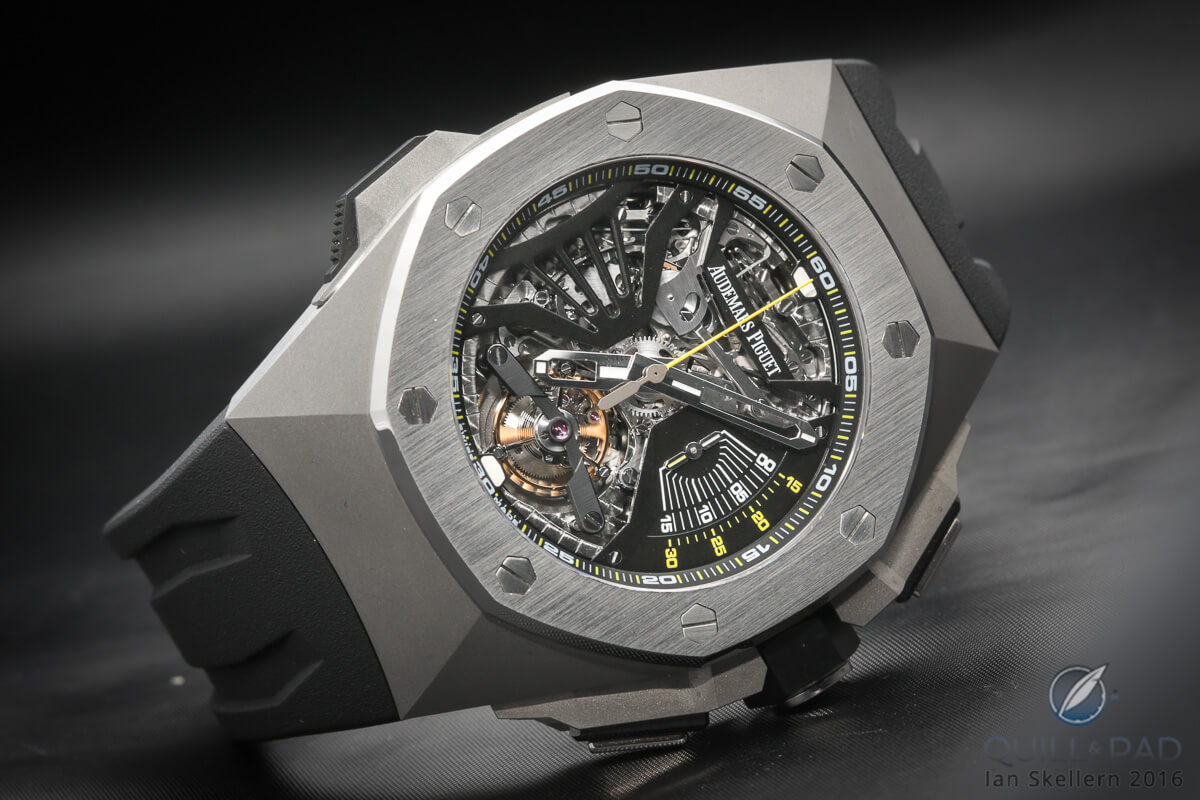
Audemars Piguet Royal Oak Concept Supersonnerie (prototype)
RS: I love the juxtaposition of old-world complications being housed in such an aggressively contemporary and rugged case. Add to that that sheer volume which with this beast chimes and you simply can’t help but sit up and pay attention to the Supersonnerie. Attaching the gong heels to a resonant membrane rather than the base plate and making the case back intentionally porous is the horological equivalent of installing an ultra-high-end speaker system.
The Supersonnerie has an elevated acoustic quality, matched by enhanced (relative to repeaters) waterproofing, reduced noise at the governor, and a chronograph that barely gets a mention. This is everything we have come to expect and admire from the benches of APRP and every bit as mechanically exceptional. It’s a very close second place for me.
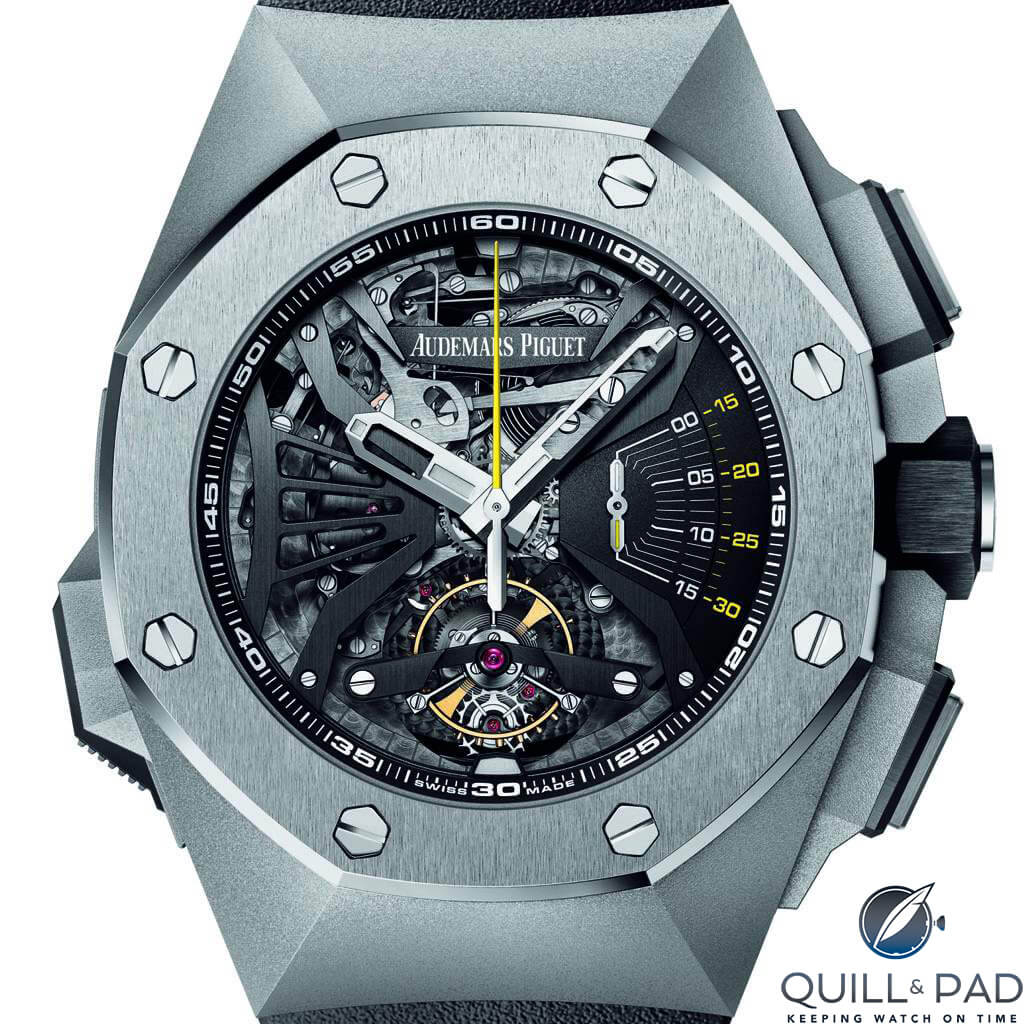
Audemars Piguet Royal Oak Concept Supersonnerie
Further reading: Hearing Is Believing: Audemars Piguet Royal Oak Concept Supersonnerie And The Science Of Sound.
Quick Facts Audemars Piguet Royal Oak Concept Supersonnerie
Case: 44 mm x 16.5 mm, titanium
Movement: manually winding manufacture Caliber 2937 with one-minute tourbillon
Functions: hours, minutes; chronograph with central sweep-seconds hand and 30-minute counter; minute repeater on two gongs
Water resistance: 20 meters / 66 feet
Price: $597,400 / 561,600 Swiss francs
Predicted Winners
Ian: Audemars Piguet Royal Oak Concept Supersonnerie (or Bulgari Octo Finissimo Minute Repeater if the former takes Aiguille d’Or)
Joshua: Audemars Piguet Royal Oak Concept Supersonnerie
Martin: Bovet 1822 Récital 18 Shooting Star Tourbillon
GaryG: Bulgari Octo Finissimo Minute Repeater
Ryan: Chronométrie Ferdinand Berthoud FB 1
And the winner of the 2016 GPHG Mechanic Exception went to Audemars Piguet Royal Oak Concept Supersonnerie (see Hearing Is Believing: Audemars Piguet Royal Oak Concept Supersonnerie And The Science Of Sound).
For more of our predictions in the 2016 Grand Prix d’Horlogerie de Genève (GPHG), please see:
Men’s Category
Tourbillon Category
Ladies Category
Ladies’ High-Mech Category
Artistic Crafts Category
Chronograph Category
Jewellery Category
Sport Category
Calendar Category
Travel Time Category
Petite Aiguille
Aiguille d’Or
Trackbacks & Pingbacks
-
[…] Tourbillon Category Chronograph Category Sport Category Calendar Category Travel Time Category Mechanical Exception Category Petite Aiguille Aiguille […]
-
[…] Men Tourbillons Ladies Ladies’ High-Mech Artistic Crafts Chronographs Jewellery Sports Calendar Mechanical Exception Petite Aiguille Aiguille […]
Leave a Reply
Want to join the discussion?Feel free to contribute!

Sorry but concerning the Piaget, the only relevant comparison is with Seiko. Only Seiko sold a watch with a comparable technical solution with the Springdrive, although Asulab developed one in their time. So while I agree that this watch is a bit weird, comes far later than Seiko, and lacks a sweep second hand, just remember that it probablay needed far more r&d than the Chanel, Bovet or Berthoud.
Solid point. The spring drive is a wonderful movement/technology, and the 700p is a wonderful incarnation of it. However, for me, the thing that is inexcusable and immediately disqualifies the watch is that Piaget decided to translate this extreme accuracy onto a dial that not only lacks a seconds hand but doesn’t even have minute increments! The idea of this makes me feel almost claustrophobic!
If Piaget can drop this movement into a chronometer-style dial I will be front row with a Piaget t-shirt on next year.